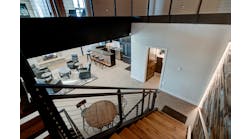For more than a century, Children’s Medical Center has strived to make life better for children. Through a $1.8 million renovation project, the hospital also has made life easier for busy parents. Children’s, which is rated as the sixth largest pediatric health care provider in the country, recently opened two new clinics: one to treat patients with multiple specialty diagnoses and another to provide pediatric primary care. With 760,000 patients visiting its Dallas and Plano, Texas, campuses and 16 My Children’s clinics yearly, the hospital renovated 10,000 sq ft of office space in the ambulatory care pavilion to alleviate the patient load in the emergency room.
McCarthy Building Companies, Inc., a Texas builder for 35 yr, teamed up with Dallas-based Angiel Electric Construction Corp. on the project. Over the last 25 yr, the electrical contracting firm has performed several jobs for the hospital, including helping to construct a sixth-floor expansion, performing a full emergency switchgear replacement, and renovating the cancer and blood disorders wing.
Facing logistical challenges. On the renovation project, the construction team was working on the middle floor of a 3-story building, and the electricians’ work zone was located directly above the operating rooms and below the vice president’s office. While the pavilion and day clinic were open from 7 a.m. to 5 p.m., the main facility is open 24 hr a day, making it imperative for the field workforce to pull night and weekend shifts to meet deadlines.
“The hospital was working all around us, and it was like building a ship in a bottle,” says Gator McCluskey, project manager for Angiel Electric. “During the process of the job, it went from a day job to a night job due to the noise level.”
As a result, Angiel Electric had to focus on facilitating communication between the electricians on the day and night shift. Once the electricians wrapped up the installation of the wiring and other infrastructure, however, they were able to return to a day shift to trim out the space and finish up the job.
The electricians not only had to alter their work hours, but also modify the material delivery due to the lack of space on the work site. With no access to a large storage yard, the contractor ordered materials for a few weeks rather than for the entire project.
In addition, because the team was working inside of a clean, sterile medical environment, workers had to pay particular attention to indoor air quality issues to prevent dust from leaving the construction site, says Matt Robben, assistant project manager for McCarthy. To meet this challenge, the team relied on a specialty suction system with HEPA filters to ensure the construction space continuously achieved negative air throughout the project.
Responding to changes. When the electricians first arrived on the project, they focused on demolishing the interior area of the second floor. To clear the space, the construction team spent two weeks removing the existing cubicles, electrical and data wiring, and walls.
“It was tricky to do the demolition because all the other systems were still up and running, and we were working on the middle floor,” says McCluskey.
After gutting the office space and stripping it down to the bare concrete walls, the construction team then focused on setting up the clinics as a large rectangle with a central reception area down the middle. That way, the clinics could share a pharmacy, waiting room, and office area, which saves a lot of space, says McCluskey.
To get the clinics up and running as quickly as possible, the team worked on a fast-track schedule. Throughout the renovation, the electricians had to adapt to numerous changes as the project progressed. For example, the construction team had to quickly and efficiently respond to a change relating to the existing HVAC duct work.
“The mechanical and plumbing systems had to be installed above and below the existing utilities that were servicing the operating rooms,” Robben says. “These utilities could not be relocated, so we had to continuously make coordination changes in the field.”
The mechanical contractor, which used Building Information Modeling (BIM) on the project, worked alongside Angiel Electric to install the new unit. The shutdown started at 3 p.m. on a Friday, and by the end of the day on Sunday, the unit had been replaced. The electricians then worked to demo the existing unit, hook up two drives, and wire the new air-handling unit to get it operational. Powering the clinics.
Because Angiel Electric has been working at the hospital for more than two decades, the firm was able to respond to the everyday working needs of the nursing staff and medical team. For example, all the hospital-grade receptacles in the exam rooms were mounted at 18 in., but Angiel recommended they be moved to 48 in. to make it easier for employees to plug in an IV pole, and for patients and visitors to power up their mobile devices.
“Our main concern is making sure the end-user is happy,” McCluskey says. “When it is all said and done, they have to use the space, and if it doesn’t work, then it’s not a good fit.”
In addition to installing the data and security raceways, the electricians also handled the fire alarm system. The office building, which is set up for Type B occupancy, features smoke detection in the main corridors and strobe lights throughout the facility. The City of Dallas requires that if are more than two people are in an exam room, electricians must install a region device in these locations.
After installing the fire alarm system, the electricians illuminated the new space by replacing the fluorescent parabolic fixtures with LED downlights. To improve energy efficiency, they also installed occupancy sensors in the exam rooms on the walls. Through the renovation project, the construction team not only helped the hospital to conserve energy, but also create two new clinics that will help to serve the health care needs of sick children and their families.
Fischbach is a freelance writer based in Overland Park, Kan. She can be reached at [email protected].


